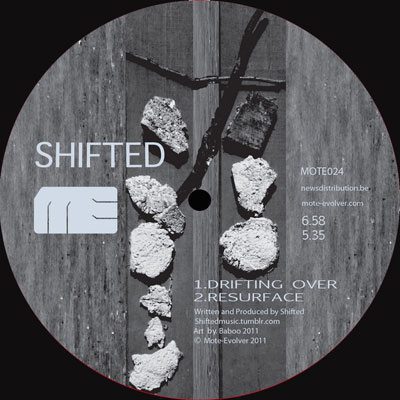It would be easy to dismiss the tracks on this EP as uninspired minimal techno, droning morosely along, amassing texture by layering beats at nodal points and squirting atmospheric keyboard chords over the top of the mix. Bad techno does exactly that, and there is more than enough bad techno to go around. Happily though, this is not bad techno, but it takes concentration to figure out why.
The narcotic effects of percussive polyrhythms have been used by tribal and esoteric groups for longer than history can record.
 There are subtleties to this EP which are not immediately obvious on a casual listen. Whilst the tracks are minimal in their elements, what elements there are are for the most part, skilfully executed. Techno often fails to engage the listener by relying too heavily on machinelike repetition of percussion motifs, or beats which fail to evolve and change over the course of the track. Purists would argue that it is exactly this machine-like quality that is the raison d'etre of the genre – it is machine-made, so why attempt to disguise that? There is logic to that viewpoint. Drum machines are more precise than human percussionists, and can be programmed to sustain complex polyrhythms along the length of a track in ways which cannot be maintained by a lone drummer.
There are subtleties to this EP which are not immediately obvious on a casual listen. Whilst the tracks are minimal in their elements, what elements there are are for the most part, skilfully executed. Techno often fails to engage the listener by relying too heavily on machinelike repetition of percussion motifs, or beats which fail to evolve and change over the course of the track. Purists would argue that it is exactly this machine-like quality that is the raison d'etre of the genre – it is machine-made, so why attempt to disguise that? There is logic to that viewpoint. Drum machines are more precise than human percussionists, and can be programmed to sustain complex polyrhythms along the length of a track in ways which cannot be maintained by a lone drummer.
The narcotic effects of percussive polyrhythms have been used by tribal and esoteric groups for longer than history can record. With sequencing technology the effect is made available to the single programmer. But splicing together a set of beats, each at different tempos, each with a different pitch, each at a separate volume, is a tricky business. Sequencing them so that they coalesce at intervals; allowing them to fade in and out of prominence; giving each percussion figure its own profile of differently-weighted hits – these are the stumbling blocks upon which a majority of techno musicians falter. Music composed via graphic user display is precise. Imbuing that precision with the nuances and progressions that are needed to compel and inspire the human ear (and get people dancing, let's not forget) is the irony of techno music – it is in the variations of the mathematical regularity that the soul of the music is found. It's all in the detail.
But splicing together a set of beats, each at different tempos, each with a different pitch, each at a separate volume, is a tricky business.
When a musician manages to get all those percussive elements right, it's not surprising that the consequent reaction is to pare back every other aspect of the song – not wanting any melodic or harmonic interference with the hypnotic effect of all these finely-arranged drumbeats. 'Structure' – the highlight of the EP, allows no more melody into the mix than some creepy Martin Hannett-style atmospherics (perhaps the title 'Control' is a nod to Hannett's work on Joy Division's 'She's Lost Control', although this is fanciful speculation). There is the heartbeat pulse of a double kickbeat throughout 'Structure', and a six-beat motif in the upper-midrange that is so quiet that it takes a concerted effort to even hear it – but between those two elements there is a subtle interaction that gives the other beats entering and leaving the composition a solid rhythmic structure to either clash with or adhere to.
Techno often fails to engage the listener by relying too heavily on machinelike repetition of percussion motifs, or beats which fail to evolve
It's impressive programming, calling upon an ear for polyrhythmic percussion that is more akin to orchestration than drumming. What tends to be lacking in this sort of minimal beats-sculpting, is the dramatic and emotional appeal of a melodic or vocal melody. But minimal techno grew out of a wish to escape the cliches of the piano topline, or the screeching female vocal sample. Instead the drama has to grow more gently, and to an extent, that emotional engagement is provided in the two B-sides: 'Drifting Over' and 'Resurface'.
'Drifting Over' and 'Resurface' are slightly more approachable in terms of dancefloor appeal, each of them carrying enough momentum and drive through their basslines and atmospherics to propel a basic groove. As songs, they convey mood and nuance more than the usual build-drop-build-breakdown narrative common to dance music, any build in tension is achieved more through accumulation of elements than escalation of tempo or volume. That said, they are recognisably within the parameters of euphoric trance-inflected dance music, and although they are a great deal more accessible and reassuring than 'Structure', they are for that very reason, not as noteworthy.
Track 1, 'Control', fails to ignite the interest though, and seems to be stuck between two roles – the contemplative introverted meditative rhythms of 'Structure', and the dancefloor-pleasing structure of the final two.Inevitably though, such judgements are subjective, what appeals to one listener is anathema to the next. The fairest criticism is to say that the vision for the track does not sit comfortably with the rest of the EP. Otherwise, this EP is deft work.
Shifted – Control EP is out now on Mote Evolver.

An observer first and foremost, Sean Keenan takes what he sees and forges words from the pictures. Media, critique, exuberant analysis and occasional remorse.
















